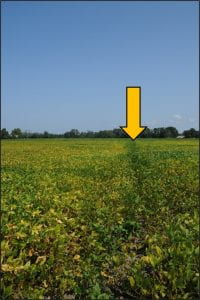Amy L. Shober, Professor and Extension Specialist, Nutrient Management and Environmental Quality, ashober@udel.edu; Jarrod O. Miller, Assistant Professor and Extension Specialist, Agronomy, jarrod@udel.edu; Mark Reiter, Associate Professor and Extension Specialist, Soils and Nutrient Management, Virginia Tech, mreiter@vt.edu

This image shows areas of the field where the soybeans that were growing in a field ditch (yellow arrow) showing less Mn deficiency symptoms than areas that have better tilth. Figure credit: Jarrod Miller, UD
Soybean is susceptible to manganese (Mn) deficiency, especially when grown on sandy, low organic matter soils like we have in Delaware. Soil Mn availability is a function of both Mn concentration and soil pH. Soil Mn converts to unavailable forms as soil pH increases. So when soil pH starts creeping above 6.2, we can start to see Mn deficiency symptoms. While Mn deficiency can be widespread across the field, we can also see Mn deficiency symptoms in small pockets in a field, often occurring after liming. Deficiency symptoms can be prevalent in areas where lime applications overlapped or where the soil is sandier than the general field; thereby changing pH more quickly and becoming higher than soils with more clay, loam, and/or organic matter. Manganese deficiencies may also reveal themselves with dry soil conditions like we have seen this summer (especially when soils were tilled soils) because soil Mn also becomes less available to plants. Interestingly, Mn deficiencies are less likely in areas of the field that stay wetter (e.g., compacted wheel tracks, field ditches) as wetter soils are less oxygenated, promoting plant available forms of Mn (as seen in the photo below). Continue reading
